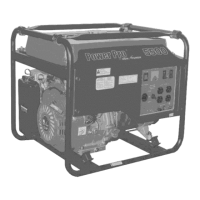Step 2- Add Gasoline
_1_WARNING: Gasoline and gas fumes are highly flammable.
• Do not fill tank near an open flame.
• Do not overfill. Always check for fuel spills.
To ensure that the generator runs Slnoothly use only FRESH, UNLEADED GAS WITH
AN OCTANE RATING OF 87 OR HIGHER. To add gasoline:
1. Make sure the generator is on a level surface.
2. Unscrew gas cap and set aside (NOTE: the gas cap may be tight and hard to
unscrew).
3. Slowly add unleaded gasoline to the fuel tank. The capacity of the gas tank is 6.5
gallons. Be careful not to overfill. The fuel gauge on the top of the generator
indicates how much gasoline is in the generator gas tank. NOTE: Gas can expand.
Do not fill the gas tank to the very top.
4. Replace fuel cap and wipe up any spilled gasoline with a dry cloth.
IMPORTANT:
• Never use an oil/gasoline mixture.
• Never use old gas.
• Avoid getting dirt or water in the fuel taN<.
• Gas can age in the tank and make it hard to start up the generator in the future.
Never store generator tbr extended periods of time with fuel in the tank.
Step 3- Ground the Generator
_i_ WARNING: Failure to properly ground the generator can result in electrocution.
Ground the generator by tightening the grounding nut against a grounding wire (see
figure 3). A generally acceptable grounding wire is a No. 12 AWG (American Wire
Gauge) stranded copper wire. This grounding wire should be connected at the other end
to a copper or brass grounding rod that is driven into the earth.
Grounding codes can vary by location. Please contact a local electrician to check the
grounding regulations for your area.
Figure 3- Attaching the Grounding Wire to the Generator
11

